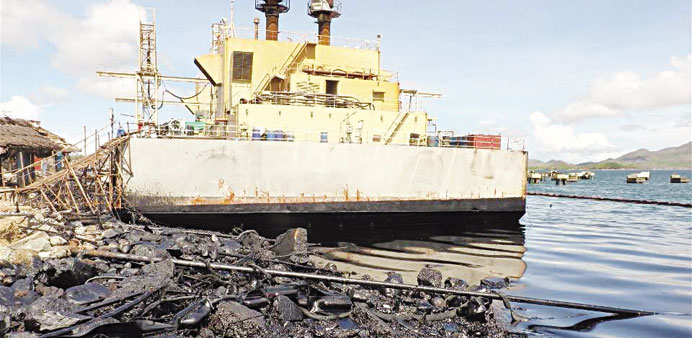Oil barge in Loilo province has spilled an estimated 850,000 litres of bunker oil, adding to the distress of typhoon survivors in a fishing village in northern Panay island in central Philippines.
IRIN/Loilo Province
Local government authorities in a fishing village in northern Panay island in central Philippines are scrambling to evacuate thousands of residents after toxic fumes from a bunker fuel leak caused levels of benzene in the air to rocket.
“We identified 1,042 families living along the contaminated coastline who needed to be relocated and began evacuating on November 23. To date, we have relocated only 544 families. We are still looking for a place to put the rest,” said Judith Tanate-Barredo, camp co-ordination cluster head for the Department of Social Welfare and Development (DSWD).
A tent city has been put up in the compound of the North Iloilo Polytechnic State College (NIPSC) to house some of the evacuees. Many public facilities like schools and gymnasiums – usually the first candidates for evacuation centres — had their roofs blown off by the super-typhoon that slammed into the region on November 8, displacing an estimated 3.8mn people, and killing more than 5,000.
Powerful storm surges brought by Typhoon Haiyan, locally known as Yolanda, carried ashore the power barge run by the government-owned National Power Corp (Napocor), destroying houses in its path and killing two people.
The hull of the barge, with 1.4mn litres of bunker oil on board, was punctured.
“We estimate that since the spill was reported on November 8 to today, some 850,000 litres of bunker oil have been leaked into the coastal waters of Estancia (municipality),” Philippine Coast Guard (PCG) Commodore Altheo Ybanez said.
Ybanez said Napocor has pledged to tow the barge to a docking facility by December 6 and to complete the clean-up within three months.
Typhoon Haiyan left villagers stranded in their destroyed homes or forced them to take shelter in makeshift temporary ones, said resident Gemalyn Gallardo.
“Where could you go to evacuate? The public school and the gymnasium also had no roof. They did not look safe (structurally).”
After the typhoon she began to experience difficulty breathing and had skin allergies, but ignored her symptoms.
“I began to worry when my other neighbours began to experience the same thing,” said Gallardo.
“Repeated exposure to benzene and inhalation can cause a burning sensation on the skin, pulmonary irritation, or acute inhalation poisoning,” said Amelita Robles, a provincial health officer.
Tests conducted by the Department of Health indicated that the toxicity levels of benzene, a colourless but hazardous substance found mostly in petroleum, reached 16.9 parts per million in the air, while an acceptable level is 0.5 parts per million.



